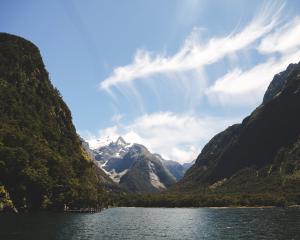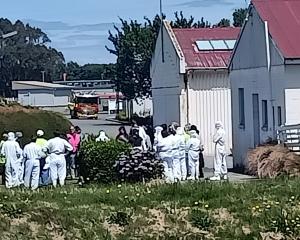
After the one-hour cruise across Lake Manapouri from Pearl Harbour deep into Fiordland National Park, a cluster of steel and concrete structures and a spider web of transmission lines strike a discordant note against the steep, forested mountains surrounding West Arm.
But the parts of Manapouri power station visible from the lake are like the tip of an iceberg. If you are lucky enough to be shown around, it is still hard to comprehend the sheer scale of a largely underground project that took 1800 workers eight years to complete.
From your vantage point on the lake, you can see a road, control building, intake gate and switchyard, all sitting on ledges carved from the side of a steep hill. From the switchyard, two sets of transmission lines loop in a single 1.2km span across West Arm on their way to join the national grid.
To know what lies beneath, you either need a tour guide or a cutaway diagram.
Behind the intake gate, water from the lake plunges 180m down huge pipes, or penstocks, before levelling out to spin up to seven turbines in a huge underground powerhouse.

The water then flows down two 10km tailrace tunnels to be discharged into Deep Cove, Doubtful Sound.
The second tailrace tunnel was built in 2002 to allow the water to flow more efficiently through the station, boosting its output from about 580 megawatts (MW) to more than 800MW.
Timeline
- 1956: Concept plans revealed.
- 1963: Wilmot Pass road construction begins.
- 1963: Powerhouse construction begins.
- 1964: Tailrace tunnel construction begins.
- 1965: Wilmot Pass road completed.
- 1967: Powerhouse construction completed.
- 1968: Tailrace tunnel completed.
- 1969 (September 14): Water flows through station.
- 1969 (Sept-Oct): Generators 1-4 commissioned.
- 1971: Generators 5-7 commissioned.
- 1971: Tiwai Point produces first aluminium.
- 1972: Power station fully commissioned.
- 1999: Meridian Energy assumes ownership.
- 2002: Second tailrace tunnel completed (cost $200m).
The electricity generated runs through cables up vertical shafts to the switchyard, and from there begins its journey along transmission lines to join the national grid in Invercargill, a big share of it continuing south to the Tiwai Point aluminium smelter.
Invercargill Mayor Sir Tim Shadbolt, whose spent a gap year before university working on the construction project, says the power station and smelter have been a "godsend" for Southland.

Sir Tim says as well as the smelter's direct employees, he estimates another 2000 people are employed by its contractors and other supporting businesses.
He is proud to have worked on Manapouri: "By drilling a hole through the Southern Alps, it means we've got sustainable, carbon-free electricity - probably for the next thousand years".
Flicking the switches
Since the 1990s, Manapouri power station has been operated remotely from Meridian Energy's Wellington office.
On weekdays it has a permanent staff of 17 - effectively a maintenance crew made up of operators, electricians, mechanical fitters, cleaners and others. During the week, one worker stays overnight to respond to alarms.

Increasing automation means he has seen the number of on-site staff fall by two-thirds during his time there.
While the technology for power generation has not changed in the power station's 50-year life, the control systems for "fine-tuning" its operation have moved with the times, he says.
Site manager Brett Horwell says it is easy to lose sight of the station's immense scale, and the beauty of its setting.
"The main challenge is to remind yourself to step back and take a look at it - you get so engrossed in what you're doing."
He and his team take pride in being the custodians of a "pretty amazing legacy" left by hundreds of workers half a century ago.

"Probably a lot of New Zealanders don't understand its role in terms of the security of New Zealand's electricity supply.
"Having something like this churning away in the back of New Zealand is pretty critical for us as a nation, because it's backing up the power system."
Meridian stopped running public tours of the power station in 2015 after WorkSafe raised concerns about safety measures in the event of a bus fire in the tunnel road to the powerhouse.
At a glance
- Two 10km tailrace tunnels from West Arm to Deep Cove
- Powerhouse 200m underground
- 2km-long road tunnel to powerhouse
- Control building and switchyard
- 21km road from West Arm over Wilmot Pass to Deep Cove
- 145km of transmission lines from West Arm to Invercargill
- Since then, the tunnel's lighting and communications networks have been upgraded, and Mr Horwell says he is keen for the region's school children, at least, to again be able to tour the station.
- But for now the tours remain on hold, although the company is planning to belatedly celebrate the station's 50th anniversary next May with a week of public open days.
Moving mountains
A 19-year-old Tim Shadbolt got a job on the Manapouri power station project in 1967 by telling the recruiter he was a "hard-rock miner from Mt Isa".
When he arrived at West Arm - annual rainfall 3m - some of the other new workers did not get off the boat.
"They just refused - the sleet was coming sideways.
"I'd just saved up enough to get there, and I certainly didn't have enough to get back home - I was hanging in there hell or high water," Sir Tim said.

"The drills were likely to dislodge rocks, especially from the ceiling.
"And waterfalls coming out of roof - they knocked you over or knocked you off the scaffolding.
"There were a lot of injuries."
Fortunately for him, his only injuries came on the rugby field or in the boxing ring; he joined both teams after learning they were a ticket to above-ground jobs.
While those working on the underground powerhouse and tunnel road stayed at West Arm, those building the road over Wilmot Pass and tunnelling the tailrace lived on board a former passenger liner, MV Wanganella, anchored in Deep Cove.

Today, Sir Tim has fond memories of the vast West Arm camp with its movie theatre and regular visits by entertainers such as Howard Morrison.
Workers would band together and hire floatplanes to fly to Manapouri and its pub.
"We could do amazing things because we were getting so well paid compared with the average worker.
"We got dirt money, danger money, isolation money."
After nine months at West Arm he was transferred to Deep Cove to build railway lines.
Despite the copious rain and sandflies, his overriding memory is of the "awe-inspiring" beauty of the area.
"It was certainly the experience of a lifetime."
By the numbers
8 years to build (1963-71)
1.4 million tonnes rock excavated
300 tonnes of explosives detonated
8 million man hours
16 deaths
 The powerhouse is 111m long, 18m wide and 39m high.
The power of gravity
The powerhouse is 111m long, 18m wide and 39m high.
The power of gravity

In 1904, government engineer Peter Hay, noting the 178m drop from the surface of Lake Manapouri to the Tasman Sea at Doubtful Sound, raised the idea of using its water for power generation.
The idea was aired again several times over the following decades, but was given serious impetus by the discovery of vast bauxite reserves in Queensland in 1955.
That discovery of bauxite ore - the world's main source of aluminium - led to growing interest in developing a cheap source of power for the energy-hungry smelting process.

Two years later, the government had advanced plans linking hydro-electric power at Manapouri with aluminium production, and in 1959, the project was officially announced.
In 1960, the government and Consolidated Zinc Proprietary Ltd (later known as Comalco) agreed the company would build an aluminium smelter at Tiwai Point and a power station at West Arm.
In return, Comalco would receive exclusive rights to Lake Manapouri's waters for 99 years.
But in 1963, the company decided it could not afford to build the power station, so the government took over the project, agreeing to build the plant and sell electricity to the company at highly reduced prices, with no provision for inflation.
 Five of the six original Guardians of Lake Manapouri, Monowai and Te Anau (from left) Wilson Campbell, Sir Alan Mark, John Moore, Jim McFarlane and Les Hutchins. PHOTO: ODT ARCHIVES
Saving a lake
Five of the six original Guardians of Lake Manapouri, Monowai and Te Anau (from left) Wilson Campbell, Sir Alan Mark, John Moore, Jim McFarlane and Les Hutchins. PHOTO: ODT ARCHIVES
Saving a lake

From 1959, it was clear the government was backing a plan to dam the Waiau River at Lake Manapouri's southeastern end that would raise the lake by 25m to 30m.
By increasing the lake's water capacity, the power station would operate more efficiently, and be able to generate power virtually all the time.
However, raising the lake would drown many of its islands and submerge large areas of native forest.
Concerns about raising the lake were expressed from the outset by a wide range of individuals and local and national organisations.
Among the earliest voices of dissent were Les Hutchins, a pioneer of tourism in Fiordland and the founder of Real Journeys, Ron McLean, a prominent farming leader from Kennington, and Victoria University scientist John Salmon.
Lending their weight to the argument were the Scenery Preservation Society and Forest & Bird, the latter organising petitions in 1960 and 1963.
By 1966, the government had realised raising the lake by 30m was impractical purely from an engineering perspective, and settled on about 8m instead.
But for an increasing number of concerned citizens, any raising beyond its natural range was unacceptable.
A turning point was a gathering in an Invercargill living room on October 20, 1969. There the Southland Save Manapouri committee was formed, and over the next three years its members would be instrumental in rallying support throughout the country.
Dunedin author Neville Peat, who wrote about the campaign in his 1994 book Manapouri Saved!, says before 1969, the fight to stop the lake raising was sporadic and localised.
The word "ecology" was barely in use, and there was little understanding of the potential impacts on shoreline vegetation, forest and wetland.
"There was a feeling in the Ministry of Works that you could engineer a project like this and still have your scenic beauty."
In the same month the Save Manapouri campaign was formed, the New Zealand Electricity Department (NZED), under growing pressure to justify its plans, commissioned a survey of the lake's shoreline and islands.
Enter Dr Alan Mark, University of Otago botany department associate professor, now Sir Alan, who went on to become one of the campaign's most prominent members.
Under Sir Alan's supervision, the survey was carried out by an honours student, Peter Johnson, during the 1969-1970 summer.
Sir Alan says the NZED had been forced to realise it had "virtually no information" on the lake's environmental and ecological values.
The survey of Lake Manapouri, and more fieldwork the following May on Lake Te Anau's shoreline by 15 botany students, showed the damage to beaches, shoreline vegetation and fauna from any lake raising would be much worse than anticipated by the project's engineers.
Sir Alan, already no stranger to controversy through his work on South Island high country tussock, joined the Save Manapouri Dunedin committee.
Mr Peat says Sir Alan's willingness to speak out on the issue - at public meetings, to journalists and in correspondence with politicians - gave scientific credibility to the campaign's arguments.
"The science showed it wasn't just the trees and the plant life that would be affected by raising the lake, but the bird and fish life as well.
"The campaign crossed over from scenery preservation to ecological and nature conservation."
Sir Alan says the results of the fieldwork were sound, and he was "willing to rest my reputation on them".
In his foreword to Manapouri Saved!, Sir Alan says the plan to raise the lake "pricked the environmental conscience" of a wide cross-section of the public.
Concern about the likely environmental impacts reached such proportions, the campaign "served, virtually alone, to firmly establish the conservation movement on the New Zealand scene".
In 1970, 264,907 New Zealanders - almost 10% of the population - signed the Save Manapouri petition - a record for the time. By the 1972 national election campaign it had become a key issue, and helped usher in a new Labour government.
In December of that year, the new government instructed the NZED that Lakes Manapouri and Te Anau would remain at their natural levels.
The following year, Prime Minister Norman Kirk honoured an election pledge to create an independent advisory body, the Guardians of Lake Manapouri, Monowai and Te Anau, to oversee management of the lake levels.
The body continues today.
The original six Guardians were Sir Alan, Les Hutchins, Ron McLean, Wilson Campbell, John Moore and Jim McFarlane - all prominent leaders of the Save Manapouri Campaign.
Sir Alan was the body's first chairman, a role he held for 26 years.
Mr Peat says the appointment of the Guardians was a bold decision by the new Government, and probably unprecedented anywhere in the world.
"I think they had made such an impact, they couldn't be ignored, and had to be part of the monitoring."
Thanks to a national protest of unprecedented scale, the Manapouri power scheme became an early example of sustainable resource use - the use of water from two lakes for hydro-electric generation while keeping lake levels within their natural range, he says.











